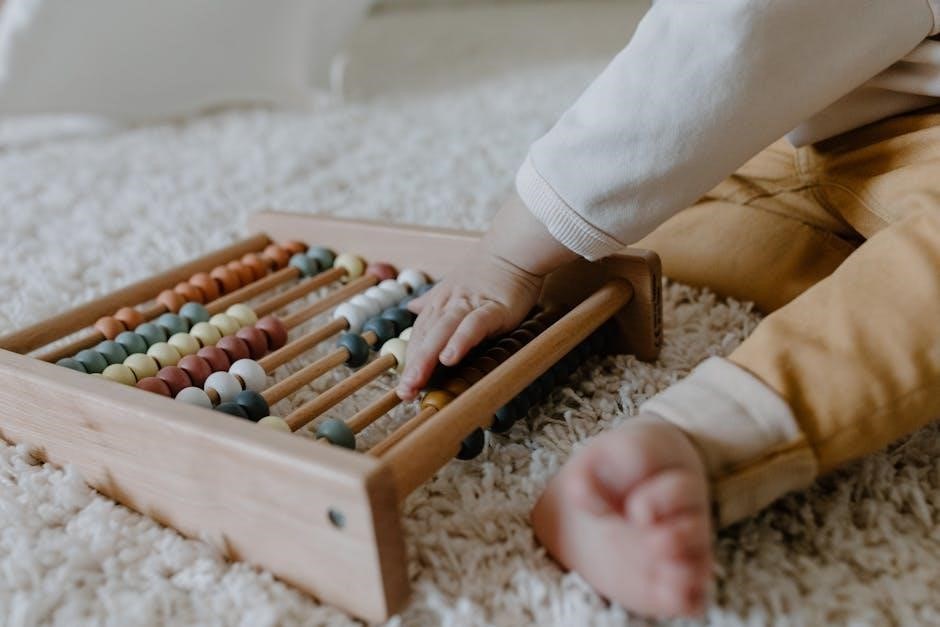Hand and Foot is a popular card game known for its strategic depth and social interaction. It combines elements of Rummy and Canasta, offering a thrilling experience for players of all skill levels; The game emphasizes teamwork, tactical planning, and quick thinking, making it a favorite among card game enthusiasts. With its unique rules and fast-paced gameplay, Hand and Foot provides endless entertainment and intellectual challenges.
1.1 Overview of the Game
Hand and Foot is a rummy-style card game that combines strategy and excitement. Played with two or more players, it involves multiple decks of cards and requires skillful melding of cards into sets and runs. The game is known for its unique structure, where players have both a “hand” and a “foot,” two separate sets of cards to manage. Strategic planning and teamwork are essential, especially in team play. The game’s complexity and social interaction make it a favorite among card enthusiasts, offering hours of entertainment and mental stimulation. Its rules vary slightly depending on the number of players, but the core objective remains consistent.
1.2 Importance of Strategy in Hand and Foot
Strategy is crucial in Hand and Foot, as it directly impacts a player’s ability to score points and win. Players must carefully plan their moves, deciding when to meld cards, which cards to hold, and how to maximize their scores. A well-thought-out strategy involves organizing cards effectively, anticipating opponents’ moves, and managing both the hand and foot efficiently. Strategic thinking helps minimize penalties from unmelded cards and maximizes points through successful melds. Adaptability and foresight are key, as the game’s dynamics can change quickly. Mastering these strategic elements is essential for triumph in Hand and Foot.

Objective of the Game
The objective of Hand and Foot is to be the first to meld all your cards by scoring points through strategic planning and effective card combinations.
2.1 Goal of the Game
The primary goal in Hand and Foot is to meld all your cards before your opponents. Players aim to rid their hand and foot piles by forming valid sets and runs. The game requires strategic planning, as melding cards in the right sequence maximizes points. Teams or individual players must work together to achieve this objective efficiently. The goal is not just to discard cards but to do so in a way that earns the highest score possible. Mastery of melding strategies and card management is key to succeeding in this fast-paced and tactical game.
2.2 Scoring Points Through Melding
Scoring points in Hand and Foot is achieved by successfully melding cards into valid sets or runs. Each card has a specific point value, with red cards worth 500 points each and wild cards (jokers and twos) worth 100 points each. Black cards, such as aces, threes, fours, and so on, have varying point values. A natural meld, made without wild cards, earns a bonus. Teams or players aim to maximize their score by strategically melding high-value cards and completing their melds before opponents. Proper planning ensures the highest possible points are accumulated during the game.

Setup and Initial Preparations
Hand and Foot begins with shuffling and dealing cards, ensuring each player receives a “hand” and a “foot.” The decks are combined, and cards are distributed evenly. Players organize their cards, separating the hand and foot for strategic planning. The goal is to prepare for melding by arranging cards optimally, ensuring no duplicates or missing cards. This setup phase is crucial for a smooth and organized gameplay experience.
3.1 Number of Players and Decks
Hand and Foot can be played with 2 to 6 players, typically in teams. The number of decks used depends on the player count: 2 decks for 2-3 players, 3 decks for 4-5 players, and 4 decks for 6 players. Each deck includes 108 cards, with jokers removed; The cards are shuffled and dealt evenly, ensuring each player receives a “hand” and a “foot.” The setup ensures a balanced game, with sufficient cards for strategic play. This structure allows for dynamic gameplay, regardless of the number of participants, making Hand and Foot adaptable to various group sizes.
3.2 Dealing the Cards
In Hand and Foot, the cards are dealt by a designated dealer, who distributes the cards evenly among all players. Each player receives a “hand” and a “foot,” with the exact number of cards varying based on the total number of players. For example, in a 2- to 3-player game, each player gets 15 cards for their hand and 15 for their foot. The remaining cards form a draw pile, with the top card turned over to start the discard pile. The dealer ensures all cards are distributed fairly, maintaining the game’s balance and preparing players for strategic gameplay.
3.3 Understanding the Hand and Foot
In Hand and Foot, each player manages two sets of cards: the “hand” and the “foot.” The hand consists of cards dealt at the start and is used to form melds during the game. The foot is a separate set of cards, also dealt initially, which players can access only after using all cards in their hand. Players must strategically manage both sets to maximize their scoring potential. The hand is used for immediate plays, while the foot provides additional opportunities for melding later in the game, adding depth to the gameplay and requiring careful planning.

Melding in Hand and Foot
Melding is the core of Hand and Foot, involving combining cards into sets or runs. It allows players to score points and progress toward winning the game.
4.1 What is a Meld?
A meld in Hand and Foot is a group of cards that can be either a set or a run. A set consists of three or four cards of the same rank but different suits, while a run is three or more cards of the same suit in sequential order. Melds are key to scoring points and progressing in the game. They must be placed face-up on the table and can be added to by any player during their turn. Melds help players eliminate their cards strategically. Proper melding is essential for success.
4.2 Types of Melds (Sets and Runs)
In Hand and Foot, melds are categorized into two types: sets and runs. A set consists of three or four cards of the same rank, such as three kings or four aces, but all of different suits. A run, on the other hand, is a sequence of three or more cards of the same suit in numerical order, like 5, 6, 7 of hearts. Both types of melds are essential for scoring points and progressing in the game. Understanding the differences between sets and runs is crucial for forming valid melds and maximizing your score.
4.3 Rules for Melding
To meld in Hand and Foot, a player must lay down a valid set or run of at least three cards. Melds can include wild cards, such as jokers or deuces, but natural cards are preferred. A meld must contain at least two natural cards if wild cards are used. Once a meld is laid down, other players can add to it if they have matching cards. The game allows strategic use of wild cards to complete melds, but players must carefully manage their hand and foot to maximize scoring opportunities and avoid penalties for unmelded cards at the end of the game.

Scoring in Hand and Foot
Scoring in Hand and Foot is based on melding cards, with points awarded for each card laid down. Penalty points are deducted for unmelded cards, encouraging strategic gameplay to maximize scores.
5.1 Calculating Points for Melds
In Hand and Foot, points for melds are calculated based on the value of the cards laid down. Each card has a specific point value, with aces and twos worth 20 points, threes through sevens worth 10 points each, and eights through kings valued at 5 points each. Jokers and wild cards typically score higher, often 30 points. Bonuses are awarded for completing large melds, such as seven-card runs or sets. Teams aim to maximize their scores by strategically melding high-value cards while minimizing penalties for unmelded cards in their hand and foot.
5.2 Penalty Points for Unmelded Cards
In Hand and Foot, penalty points are assessed for any unmelded cards remaining in a player’s hand or foot at the end of the game. Each card is assigned a penalty value: jokers and wild cards are worth 30 points, aces and twos are 20 points each, threes through sevens are 10 points each, and eights through kings are 5 points each. These penalties are deducted from the team’s total score. The goal is to meld all cards to avoid penalties, as the team with the lowest total penalty points often wins. Strategic planning is crucial to minimize these deductions.
5.3 Strategy for Maximizing Scores
Maximizing scores in Hand and Foot requires a combination of skill, foresight, and teamwork. Players should prioritize melding high-value cards early to accumulate points quickly. Organizing cards into potential sets and runs during the initial rounds helps identify the best opportunities for scoring. Communication with teammates is key in team play, ensuring coordinated melding strategies. Additionally, managing wild cards effectively can significantly boost scores. Minimizing penalties by efficiently using all cards is equally important. By balancing short-term gains with long-term planning, players can optimize their scoring potential and outperform opponents. Strategic play is essential for achieving victory in this engaging card game.

Gameplay Process
Hand and Foot begins with dealing cards, followed by turns where players draw, meld, and discard. The first player to meld all cards wins the game.
6.1 The Flow of the Game
The flow of Hand and Foot involves a structured sequence of actions. Each player starts by drawing a card from the deck or taking the discard pile. They then attempt to meld cards from their hand or foot, aiming to create valid sets or runs. After melding, the player discards one card to end their turn. This cycle continues, with players strategically managing their cards to maximize points. The game progresses until one player successfully melds all their cards, triggering the end of the round and the calculation of scores.
6.2 First Turn and Subsequent Turns
The first turn begins with the player to the left of the dealer drawing two cards from the deck. They must then attempt to meld if possible, setting the game’s momentum. In subsequent turns, players draw one card and have the option to meld, laying down cards strategically. Each turn allows players to build on existing melds or create new ones, with the goal of minimizing unmelded cards. The game demands constant adaptability, as players must think ahead to maximize their score while disrupting opponents’ strategies.
6.3 Using the Foot in Gameplay
The Foot is a critical component in Hand and Foot, serving as a second set of cards that remains untouched until the player’s Hand is fully melded. Once the Hand is exhausted, the player can pick up the Foot and begin melding its cards. This strategic element allows players to extend their turns and maximize scoring opportunities. The Foot adds complexity and depth to the game, as players must carefully plan when to unveil it. Properly utilizing the Foot can turn the tide of the game, enabling players to achieve higher scores or complete challenging melds.

Winning the Game
Winning Hand and Foot requires successfully melding all cards in both the Hand and Foot, ensuring no cards remain unmelded. The team with the highest score at the end of the game is declared the winner.
7.1 Conditions for Winning
To win at Hand and Foot, a player must successfully meld all the cards in both their Hand and Foot. The game concludes when one team or player has no remaining cards to play. The winning team is determined by the highest score, calculated by adding points from melded cards and deducting penalties for unmelded cards. The game emphasizes strategic planning and teamwork, as players must work together to maximize their score. Victory is achieved when all cards are melded, and the highest score is secured, showcasing a player’s mastery of the game’s rules and strategies.
7.2 Strategies to Ensure Victory
To ensure victory in Hand and Foot, players must adopt a strategic approach. Focus on melding high-value cards early to maximize points and reduce penalties. Communication with teammates is crucial, especially in team play, to coordinate melds effectively. Prioritize using all cards in both the Hand and Foot to avoid penalties. Pay attention to opponents’ moves to anticipate their strategies and block their melds when possible. Efficiently managing your cards and planning ahead can significantly improve your chances of winning. A well-executed strategy balances quick melding with tactical planning to secure the highest score.

Variations of Hand and Foot
Hand and Foot offers exciting variations for different player counts, from 2 to 6 players. Each variation adapts the core rules to suit the number of participants, ensuring dynamic gameplay and strategic challenges for all group sizes.
8.1 Rules for 2 Players
In a two-player game of Hand and Foot, each player uses two decks of 54 cards, including jokers. Each player receives two sets of 22 cards: one for the Hand and one for the Foot. The remaining cards form the draw pile. Players take turns drawing cards and attempting to meld sets and runs. The objective is to meld all cards in both the Hand and Foot before the opponent. Strategy is key, as players must balance quick melding with careful planning. Penalties apply for unmelded cards at the end of the game. This variation demands focused individual play.
8.2 Rules for 3 Players
When playing Hand and Foot with three players, the game is typically played individually rather than in teams. Three decks of 54 cards each are used, including jokers. Each player receives 22 cards for their Hand and 22 for their Foot, with the remaining cards forming the draw pile. The objective remains the same: meld all cards in both the Hand and Foot before others. Strategy involves carefully managing melds and using wild cards effectively. Players must lay down their initial melds to start, and the game progresses with each player building on their own melds. Penalties apply for unmelded cards at the end.
8.3 Rules for 4 Players
Hand and Foot for four players is typically played in teams of two. Three standard decks of 54 cards, including jokers, are used. Each player receives 22 cards for their Hand and 22 for their Foot, with the remaining cards forming the draw pile. Teams work together to meld all cards in both their Hands and Feet before the opposing team. Strategy involves coordinating with your teammate and using wild cards effectively. The game ends when one team successfully melds all their cards. Penalties are applied for any unmelded cards, making strategic planning crucial to minimize points lost.
8.4 Rules for 5-6 Players
Hand and Foot with 5-6 players requires adjustments to team dynamics and card distribution. For 5 players, the game is typically played as 2 vs. 2 vs. 1, while 6 players form 3 vs. 3 teams. Four standard decks of 54 cards are used to accommodate the larger number of participants. Each player still receives 22 cards for their Hand and 22 for their Foot. The objective remains the same: meld all cards first. The game becomes more fast-paced, with increased emphasis on coordination and strategy to outscore opponents. Larger teams allow for more complex meld combinations and higher scoring potential.

Common Terms and Glossary
Key terms in Hand and Foot include Meld (combining cards), Set (three/four of a kind), Run (sequential cards), Hand (initial cards), and Foot (additional cards).
9.1 Key Terms in Hand and Foot
In Hand and Foot, essential terms include Meld (combining cards into sets or runs), Set (three or four cards of the same rank), and Run (sequential cards of the same suit). The Hand refers to the initial set of cards dealt to a player, while the Foot is a separate set of cards that can be used later in the game. Wild Cards (like jokers) can substitute for any card, and Black Threes act as blockers, preventing melding. Understanding these terms is crucial for mastering the game’s rules and strategies. Proper terminology helps players communicate effectively and follow the game’s flow seamlessly.
9.2 Understanding Melding Terminology
Melding terminology is central to Hand and Foot. A Meld is a group of three or more cards played together, either as a Set (same rank, different suits) or a Run (sequential ranks in the same suit). Wild Cards (jokers or twos) can substitute for missing cards in a meld, while Black Threes are unique as they cannot be part of any meld. Understanding these terms helps players communicate effectively and execute moves confidently. Proper use of melding terms ensures clarity and adherence to the game’s rules, making gameplay smoother and more enjoyable for everyone involved. Mastery of this terminology is essential for success in Hand and Foot.
Tips for Success
- Mastering Hand and Foot requires strategic melding, effective hand and foot management, and clear communication with your team.
- Keeping track of played cards helps anticipate opponents’ moves.
10.1 Improving Your Strategy
Mastering Hand and Foot requires a blend of foresight, organization, and adaptability. Start by prioritizing high-value cards for melding early to maximize points. Organize your hand and foot strategically, grouping potential sets and runs. Pay attention to discarded cards to anticipate opponents’ moves and block their melding opportunities. Communicate effectively with your partner to coordinate plays and avoid duplication of efforts. Stay flexible and adjust your strategy based on the cards left in the deck. By combining these tactics, you can enhance your gameplay and increase your chances of winning.
10.2 Managing Your Hand and Foot Effectively
Efficiently managing your hand and foot is crucial for success in Hand and Foot. Keep your hand organized by grouping similar cards together, making it easier to identify potential melds. Regularly review your foot to plan future moves and avoid holding onto unmeldable cards. Prioritize using high-value cards early to reduce penalty risks. Maintain a balance between playing defensively and offensively, ensuring you adapt as the game progresses. By managing your cards wisely, you can optimize your scoring opportunities and outmaneuver your opponents effectively.

Comparison with Similar Games
Hand and Foot shares similarities with Canasta and Rummy but stands out with its unique two-card set system, offering deeper strategy and complexity than traditional Rummy.
11.1 Hand and Foot vs. Canasta
Hand and Foot and Canasta are both popular card games with similarities but distinct differences. Hand and Foot uses two decks, while Canasta typically uses four. In Hand and Foot, players manage both a “Hand” and a “Foot,” whereas Canasta involves only one set of cards. Melding rules differ: Hand and Foot requires three cards to start, while Canasta demands seven for a straight. Scoring systems also vary, with Hand and Foot rewarding bonus points for going out first, while Canasta focuses on card values. Both games emphasize strategy, but Hand and Foot is often considered more complex due to its dual-card management system.
11.2 Differences from Other Rummy Games
Hand and Foot differs from other Rummy games in its unique dual-card management system. Unlike traditional Rummy, players must manage both a “Hand” and a “Foot,” adding complexity to the gameplay. The game also requires three cards to start a meld, unlike some Rummy variants that allow melding with two cards. Additionally, Hand and Foot incorporates bonus points for going out first, which isn’t common in all Rummy games. These distinct features make Hand and Foot a challenging and strategic variation that stands out from other Rummy-style card games, offering a fresh experience for players.
Hand and Foot offers a delightful blend of strategy and entertainment, making it a beloved card game for players seeking both fun and intellectual challenge.
12.1 Summary of Key Points
Hand and Foot is a dynamic card game that combines strategy, teamwork, and skill. Players aim to meld cards to score points while avoiding penalties. The game requires careful planning and adaptability, making it appealing to both casual and competitive players. With variations for different player counts, Hand and Foot offers versatility and excitement. Its unique rules, such as using both a hand and foot, set it apart from other card games. By mastering melding techniques and strategic thinking, players can enhance their chances of victory and enjoy a rewarding gaming experience.
12.2 Final Thoughts on Mastering Hand and Foot
Mastery of Hand and Foot requires practice, strategic thinking, and a deep understanding of the game’s rules. As players gain experience, they develop the ability to anticipate opponents’ moves and optimize their own melding strategies. Patience and adaptability are key, as the game’s dynamic nature demands quick decision-making. By balancing luck with skill, players can elevate their gameplay and enjoy the satisfying challenge of this beloved card game. Continuous learning and refinement of techniques ensure long-term success, making Hand and Foot a rewarding and engaging hobby for years to come.

